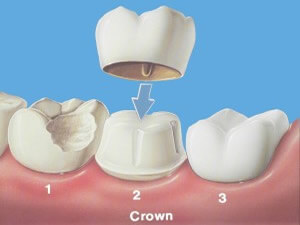
Temporary: A temporary crown or bridge will be placed on the prepared teeth while the permanent restoration is being made. The temporary serves very important purposes. It protects the exposed dentin so it is not sensitive, prevents food and bacteria from collecting on the tooth preparation, and prevents the tooth from shifting or moving, which can make seating of the permanent restoration more difficult or even impossible. The temporary is placed with a cement that is designed to come off easily, so avoid chewing sticky foods such as gum or taffy or anything very crunchy. Use your toothbrush to clean the temporary as you normally do your other teeth. However, when flossing, it is best to slide the floss out below the contact rather than popping up through the contact between the temporary and the tooth next to it.
If your temporary comes off between appointments, even if there is no discomfort, slip it back on and call our office in order to have us recement it for you. It cannot be stressed too much how important this is.
A little denture adhesive or even toothpaste placed inside the crown can help to hold it in place in the interim.
Sensitivity: Sensitivity, especially to cold, is common while you are wearing the temporary. If you experience this, avoid extremely hot or cold foods and beverages. It is normal to have discomfort in the gums around the tooth after the anesthesia wears off. If your gums are tender, rinse with warm salt water by dissolving 1/2 teaspoon of salt in an 8 oz. glass of warm water. An analgesic, such as whatever you would take for a headache, will help to increase your comfort.
Permanent Crown or Bridge: Typically, we will have your permanent crown or bridge around 2 weeks after the appointment which the tooth or teeth were prepared. It may take a few days to get used to the new crown or bridge, after your permanent restoration is finally cemented. If your bite feels high or unbalanced, please be sure to call our office for an appointment for a simple adjustment.
Home Care after seating your Permanent Crown or Bridge: Although crowns and bridges are often the most durable of all restorations, the underlying tooth is still vulnerable to decay, especially at the interface between the tooth and crown. It is important to resume regular brushing and flossing immediately. Daily home care and regulating your intake of sugar-containing foods will increase the longevity of your new restorations.
If you have any problems or unanswered questions, please feel free to call our office at 604-805-2500 any time so we may be of assistance to you.